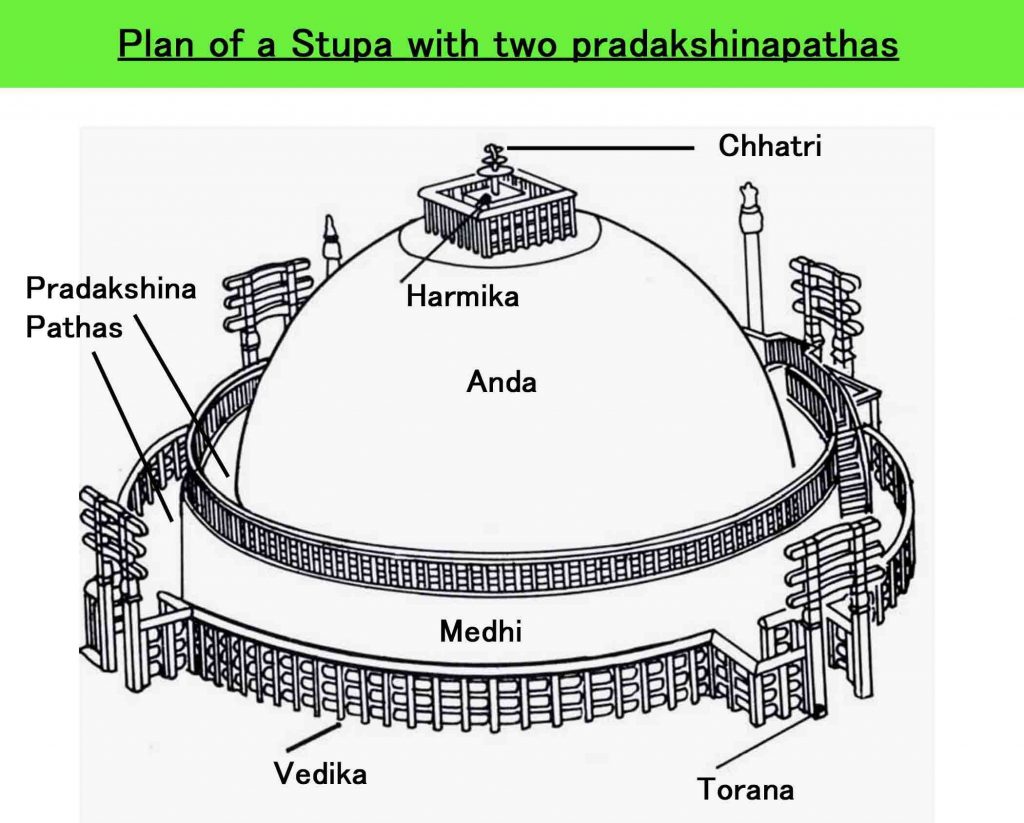Context:
Kesaria Buddha stupa in east Champaran district of Bihar is waterlogged following floods in some parts of the district.
Relevance:
Prelims, GS-I: Art and Culture
Dimensions of the Article:
- About Stupas
- About Kesaria Buddha stupa
About Stupas
- The Stupas holds the most important place among all the earliest Buddhist architecture. They offer the earliest sculptural representations of important episodes in the Buddha s life and of the Jataka stories.
- A Stupa is a dome-shaped sacred burial mound of brick which was used to house Buddha’s relics or to commemorate significant facts and events related to Buddhism.
- The earliest archaeological evidence for the presence of Buddhist stupas dates back to the late 4th century BCE. In India, Sanchi, Sarnath, Amaravati and Bharhut are among the oldest known stupas.
Characteristics of Stupas
- Initially, mounds of Earth are taken to form the core of the stupa. In due course of time, the earthen mound is encased in bricks. The brick encasing is sometimes superimposed by a cover of stones.
- Stupas are usually built on a foundation laid with blocks of stone or bricks. On this foundation, a hemispherical dome (anda) was raised.
- In later years, the drum of the stupa became more elongated and elevated. Almost it took the form of a cylindrical vessel.
- On the truncated top of the hemisphere, a harmika is placed, surrounded by a railing.
- The stupa is enclosed by a vedika. At Barhut, Sanchi and Amaravati the vedika consisted of upright pillars with three transverse bars known as the suchi. The railing is provided with four gateways.
- A path of circumambulation (Pradakshinapath) runs around the stupa at the ground level within the railing.
- Toranas were ceremonial gateways around the stupas.

About Kesaria Buddha stupa
- The Kesaria Buddha stupa is said to be the tallest and the largest Buddhist stupa in the world.
- It is located in Kesariya, at a distance of 110 kilometers from Patna, in the East Champaran district of Bihar.
- It has a circumference of almost 400 feet and stands at a height of about 104 feet.
- The first construction of the Stupa is dated to the 3rd century BCE. The original Kesaria stupa probably dates to the time of Ashoka (circa 250 BCE), as the remains of a capital of a Pillar of Ashoka were discovered there.
- The current stupa dates to the Gupta Dynasty between 200 AD and 750 AD and may have been associated with the 4th century ruler Raja Chakravarti.
- The stupa mound may even have been inaugurated during the Buddha’s time, as it corresponds in many respects to the description of the stupa erected by the Licchavis of Vaishali to house the alms bowl the Buddha has given them. In ancient times, Kesaria was under the rule of the Mauryas and the Licchavis.
-Source: The Hindu




